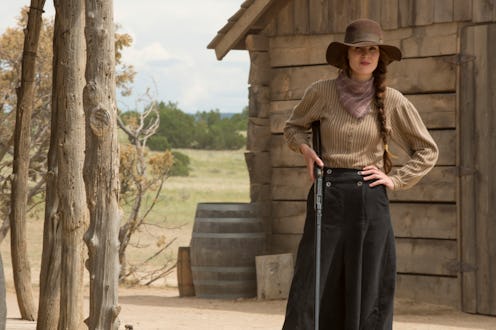Entertainment
'Godless' Challenges The Idea That Men Were The Only Ones With Real Power In The Wild West

Netflix's latest miniseries, Godless, is a Western already drawing favorable comparisons to some of the genre's best entries. Relatable characters and detailed settings make a Western stand out, so it's natural to wonder if Godless is based on a true story. While the Netflix series is not explicitly based on any real person, it has a realistic feel, because creator Scott Frank was inspired by the real history of mining towns in the late nineteenth century in the Southwest. In an interview with Variety, Frank said that the town of La Belle is based on his research of the period. "Sometimes all of the men would die in a single day in an accident, and the women would be left there... Sometimes they would all leave, and sometimes they would be stranded and have to make the town work," Frank said. "I thought, 'Oh, that’s it.'"
And while there's no easily found town named something close to La Belle known for being attacked by outlaws or staffed entirely by women after a mining collapse, there is a history of small mining communities all over the New Mexico territory. In fact, because those towns were often abandoned after either the natural resources or manpower evaporated, according to the New Mexico True tourism board, there are dozens of ghost towns that you can visit, still preserved after over a hundred years. These towns are now "haunting ties to days that used to be," the tourism board says, and they "witnessed some of America’s most romantic and rapacious history."
And while that history may well have been "romantic and rapacious," Godless is leaning into the dark and dangerous side of the period. Jeff Daniels' outlaw, Frank Griffin, rides into Le Belle with an ax to grind and an itchy trigger finger. "He’s a very dysfunctional, confused, mentally unstable person wandering around the 1880s... Put a bullet in the guy’s head, and then quote the Bible. Just another Thursday,” Daniels told Variety. And the New Mexico territory was indeed home to many outlaws during that period. In the mid-1870s, notorious gunslinger Billy the Kid moved to New Mexico, where he participated in the "Lincoln County War," a proxy war between two ranch owning cattle barons that eventually roped in several competing gangs.
Ultimately, Billy the Kid was killed by sheriff (and notorious Wild West figure himself) Pat Garrett in 1881, a bit earlier than Godless is taking place. But the overall atmosphere of the series, and the danger that's echoing around a vulnerable town that just lost half its population is informed by the period. Frank Griffin may be more poetic and cinematic than the real outlaws that rode around the New Mexico area in the 1880s, but the danger he represents is relatively accurate.
Like in Godless, there were also many real women who found greater empowerment in the West than they would have ever had in the Eastern United States. In La Belle, that's because there's literally fewer men than women, but in real life, women in the Old West did sometimes have greater freedoms, Time Magazine points out in a collection from historians and authors called "Women and the Myth of the American West."
"Everything from the right to vote to equal pay for women teachers to more liberal divorce laws" was available out West for some women, Virginia Scharff points out, but that was largely limited to white women with some amount of money or resources. Native women, Mexican women, and Chinese immigrants were all discriminated against both culturally and, in some cases, legally, Time points out. "State policies throughout much of the Western states denied Asians the right to own land as well as interracially marry. Furthermore, some women were forced to migrate to work in the sex industry," author Judy Tzu-Chun Wu writes.
So while Godless is telling a very specific story, one that allows for white women to be empowered by their Western setting, and one that perhaps creates a version of the Western outlaw that's a bit more dramatic than the hired guns that stalked New Mexico in real life, it's succeeded by not being totally beholden to real life, but by taking select inspiration where it makes the story richer.